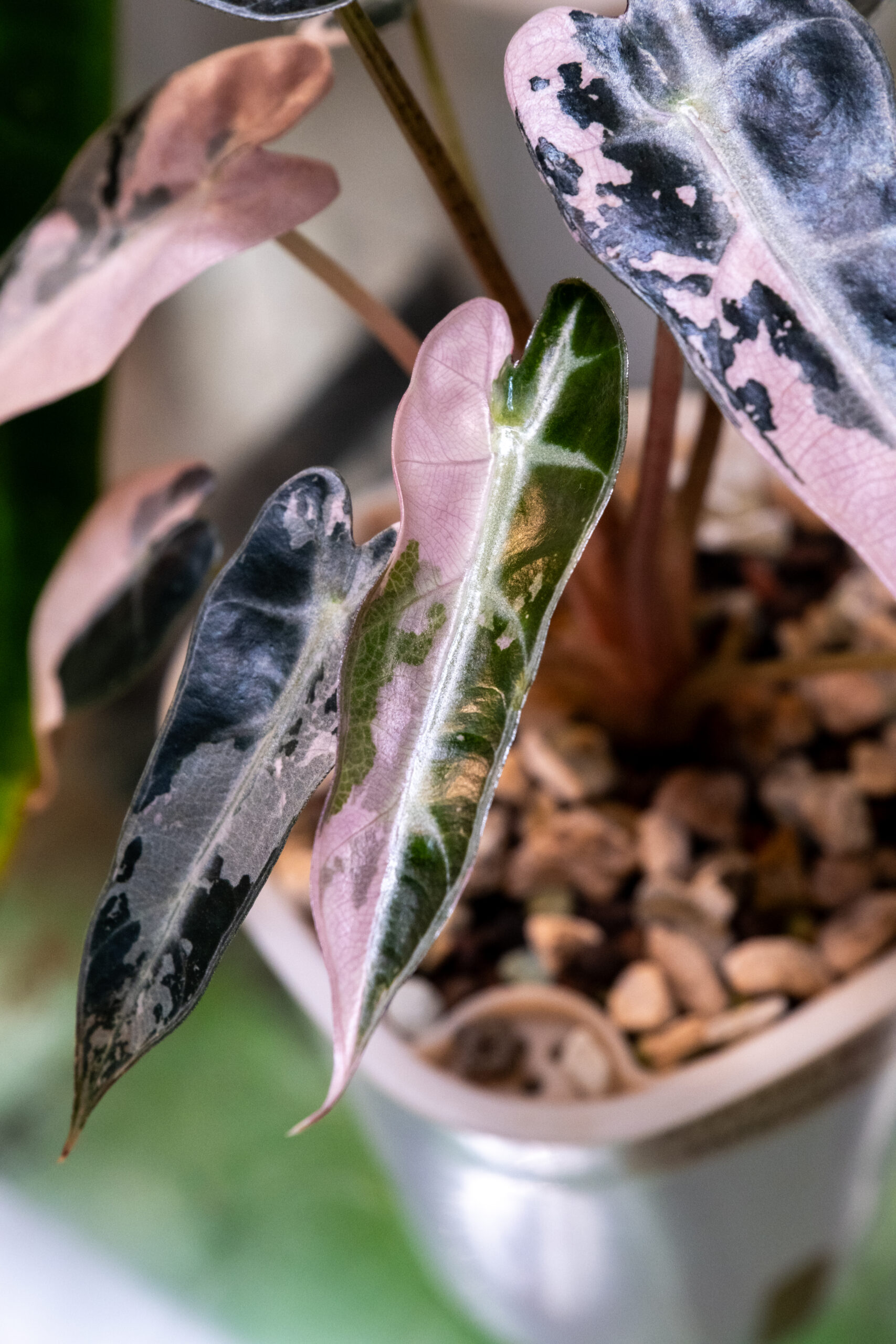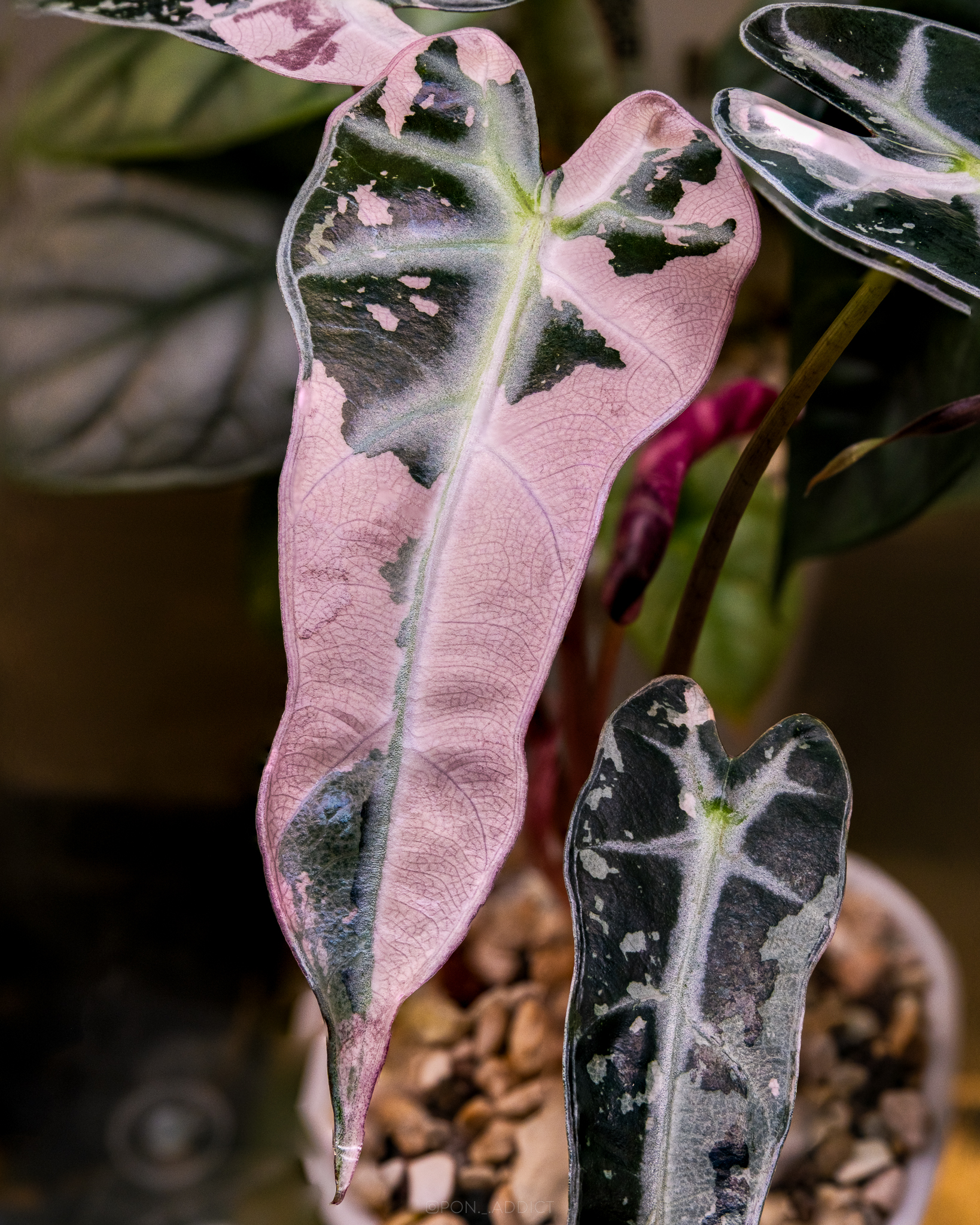Alocasia Bambino Pink Variegated
- Care Summary
- Plant Information
- Light & Environment
- Water & Nutrition
- Transitioning & Roots
| Light | PPFD 100–250 μmol/m²/s |
| Temperature | 4 |
| Humidity | 60-80% |
| VPD | 0.65-0.9 |
| Medium | Fine/Coarse PON |
| Irrigation | NWS |
| pH | 5.5-6.0 |
| EC | 0.8–1.0 mS/cm |
| Feed Plan | Variegated Alocasia Feed V3 |
Alocasia Bambino, in its base green form, is a dwarf hybrid derived from Southeast Asian Alocasias native to tropical rainforests. The Pink Variegated cultivar stands out for its chimeral variegation — pink patches that lack chlorophyll, giving the plant a striking, candy-striped appearance. However, this beauty comes with trade-offs. The pink sections can’t photosynthesize, making the plant more dependent on its green areas and thus sensitive to both light levels and nutrition.
- Native Habitat: Southeast Asian tropical forests, growing under dense canopy in humid, well-draining soils.
- Growth Habit: Upright, compact, with thin, dark petioles.
- Size: Typically grows 20–40 cm tall — perfect for desktops or shelf displays.
- Variegation Type: Chimeral, meaning the pink portions lack chlorophyll, affecting photosynthesis and overall vigor.
- Toxicity: Contains calcium oxalate crystals, which are toxic to pets and humans if ingested.
Light
Because pink variegation reduces photosynthetic surface area, Alocasia Bambino Pink Variegated needs brighter light than fully green counterparts. However, too much direct light risks leaf burn, especially in semi-hydroponics where water availability and heat stress are interlinked.
- Ideal PPFD Range: ~100–250 μmol/m²/s
- Daily Light Integral (DLI): ~6–10 mol/m²/day
- Photoperiod: ~12–14 hours in indoor setups
Environment
VPD (Vapor Pressure Deficit): Aim for 0.5–0.8 kPa. Variegated Alocasias transpire less efficiently, so a slightly lower VPD prevents desiccation of pink tissue.
Temperature:
Day: 23–28°C
Night: no lower than 18°C
Humidity: Optimal 60–80%. Higher humidity helps reduce transpiration stress due to reduced photosynthesis in variegated tissue.
Alocasia Bambino Pink Variegated thrives in PON due to excellent aeration and moisture regulation. However, overwatering is still a risk because the roots remain sensitive to saturation despite PON’s drainage properties.
- Maintain the water reservoir ~1/3 the pot height; let it drop periodically to encourage oxygen exchange.
- Monitor root zone EC frequently to avoid salt buildup.
Nutritional Requirements
Pink-variegated cultivars have slightly lower metabolic demand than green forms because chlorophyll-deficient tissue contributes less to growth. However, micronutrients supporting pigment stability, like manganese, zinc, and magnesium, are crucial to maintain the pink coloration.
Nutrient Priorities for Variegated Alocasia:
Micronutrients: Iron, manganese, and zinc support chlorophyll synthesis in green tissue and stability in variegated sections.
Nitrogen: Keep low to moderate; high N triggers excessive green regrowth, overshadowing variegation.
Potassium: Key for osmotic balance and variegation vibrancy.
Phosphorus: Vital for root development, especially in young plants.
Calcium & Magnesium: Essential for cell structure and variegation quality.
Nutritional Considerations
- Pink variegation fades if N or Mg is deficient—but can also be overwhelmed by excess nitrogen.
- Iron chelates (Fe-DTPA) are beneficial because variegated leaves are prone to chlorosis.
- Use biostimulant foliar sprays like Liquid Gold Leaf Photo+ to enhance photosynthesis in low-light conditions without increasing root EC.
Alocasia Bambino Pink Variegated transitions well into PON, but slow acclimation is critical. Sudden shifts shock roots, leading to leaf drop and reversion of variegation.
Transitioning Steps:
- Rinse thoroughly: Remove ALL soil particles from roots. Soil residues promote rot in semi-hydroponics.
- Cut mushy or black roots. Healthy roots are firm and white/beige.
- Inoculate: Apply mycorrhizae (e.g. ORCA®) at 0.25 ml/L for initial soak. Promotes faster root adaptation.
- Start with no reservoir. Keep PON barely moist for 7–10 days. Gradually introduce a shallow water reservoir afterward.
- Lower EC: During transition, halve usual nutrient concentrations to reduce osmotic stress.
- Humidity dome: Use ~80% RH for the first week if transitioning a stressed plant or recently imported specimen.
Root Care in PON
- Variegated Alocasia roots are prone to rot under stagnant conditions. Keep water oxygenated by:
- Allowing the reservoir to dry down periodically.
- Using enzymatic additives like CANNAZYM weekly to break down organic debris.
- Check roots monthly for browning or mushiness. Healthy roots should remain white or pale tan.
- Inoculants like ORCA® help maintain a microbial balance, protecting roots from Pythium or other pathogens.
| Week | Action |
|---|---|
| 1 | Barely moist PON, no reservoir, high humidity |
| 2 | Shallow reservoir (0.5–1 cm) |
| 3 | Increase reservoir height to ~1/3 pot depth |
| 4 onward | Full semi-hydro regime |

